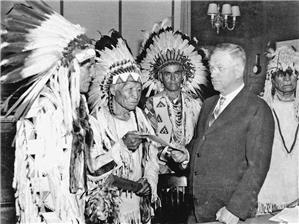On June 18, 1934, the Wheeler-Howard Act, also known as the Indian Reorganization Act, reverses the United States policy favoring Indian assimilation and becomes the basis for policies that recognize the right of self-determination for Native Americans. The law curtails the land allotment system, permits tribes to establish formal governments with limited powers, and allows the formation of corporations to manage tribal resources. Funds are authorized for educational assistance and to assist tribes in purchasing tribal lands.
Assigning Tribal Lands
U.S. Government Indian policies had been guided by the Dawes General Allotment Act of 1887, which had as its aim the total assimilation of individual Native Americans into American society as small farmers. Tribal lands were assigned to individual members who were free after 25 years (if the government deemed them "competent") to sell off their allotments. Unassigned lands were then made available for homesteaders. By 1932, non-Natives had taken over two-thirds of the 138 million acres (in 1887) of reservation lands.
In 1928, the Meriam Report on the extreme poverty on Indian reservations demonstrated the failure of the policy of assimilation.
In response to the Great Depression, John Collier (1884-1968), Commissioner of Indian Affairs in the Franklin D. Roosevelt administration, developed plans for reservation-centered relief programs and official support of tribal governments. Collier believed tribes could restore their identities and cultures through local organization. With some changes, Collier's plan was enacted into law as the Indian Reorganization Act. Tribal members were permitted to vote on whether or not to accept the act. In Washington, the Colville, Spokane, Chehalis, Shoalwater, Lummi, and Yakima tribes rejected the pact.
In Puget Sound, traditions of intermarriage among tribes and with non-Indians, and the assignments of several tribes to a single reservation conflicted with the vision in the law of tribal identity being attached to a reservation. The livelihoods of many Northwest Indians were tied to fishing and logging and day labor rather than to farming on reservations. Landless tribes such as the Duwamish had governing organizations, but no reservation, and this left them in legal limbo. Some Indians had to transfer allegiance to new tribal governments in order to preserve their economic rights.
The law enabled tribes to develop formal governments on reservations and gave them a means to buy back lands lost in the allotment system. Healthcare and education on reservations improved as well. The law had a negligible impact on Puget Sound Native Americans until the 1940s, when individuals working in war plants and serving in the military returned with new ideas.

